In a recent post, I wrote about how the Club One Fitness program in Second Life helped me lose 20 pounds, lower my blood pressure, and make permanent changes to my lifestyle.
A skeptic might read that and say: “Well, sure, you spent four hours a week in support sessions with fitness and nutrition experts. Now if you had spent that time in a physical facility, imagine how much more progress you might have made!”
To address that question, Club One actually ran two groups of 40 people each — one virtual, one in a physical facility. With the same program in each one. Well, maybe except for the part where you get to fly a magic carpet in the virtual facility.
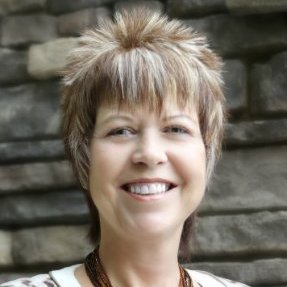
“The physical club program was as equivalent to the virtual world program as we could make it,†said Celeste DeVaneaux, creative director of Club One Island in Second Life.
The result was that the the virtual group lost more weight – eight pounds versus six pounds – lost more body fat, and lost more inches around the waist. In addition, more people stuck with the virtual program than the physical one – 25 finished the virtual program, but only 20 completed the physical one.
One interesting aspect was that most of the drop-outs in the virtual program happened at the start.
“The biggest barrier was the technology, in the computers being up to speed, and being comfortable in the virtual environment,†said DeVaneaux. “Once that settled in, then our drop-out rate was extremely low.â€
By comparison, the drop-out rates in the physical world control group were steady throughout the program. “People got bored or injured,†she said. “Their reasons for dropping out were completely different.â€
The research project was repeated twice – once running from January to March, and a second time from July through September, at no cost to the participants.
“We started out doing research because we knew it would be very difficult for a consumer to believe that they could lose weight in a virtual environment,” she said. “Doing the research also helps us give content on the website and in our marketing. The barrier of disbelief is reduced.”
The research project also results in favorable publicity, she added.
“It’s the only fitness club in the country that’s doing anything like this,” she said. “We’re very cutting edge.”
Official launch in January — free open house for the holidays
Those who didn’t get in for the free research trials might want to stop by during the holidays, when the facility will be open to the public on November 13 for a six-week open house. There will be holiday parties and other activities that will give people the opportunity to come and experience the facility and its offerings.
“I’m sure there will be a number of competitors coming in and looking at it!” she added.
Registration for the next January-March session will open on December 15. Price for the 12-week program is $750 and includes the four sessions per week, plus unlimited use of island facilities and tools.
For the cash strapped, there is also an option to rent an apartment on the island for $20 a month that provides access to the tools and facilities, without the support groups and personal attention from fitness and nutrition experts.
In addition, Club One will be playing host to another research group, of 100 people, based in Indiana University.
Filling a desperate need
San Francisco-based Club One, Inc. has over 20 years of experience trying to make Americans more physically fit.
“And what we know is that Americans keep gaining weight, and only 20 percent are doing anything to change their situation,” said DeVaneaux.
Fitness clubs aren’t working. Even clubs located at work places aren’t getting returns on their investments, she said.
“The country keeps educating, but not making any progress,†she said.
Club One and its competitors, for example, have been trying to address this problem, not just with exercise equipment, but a variety of support programs and other tools. And it doesn’t work.
“The attrition rate is really high,” she said. “The industry keeps adding new players, there are more and more clubs being built in this country, but none of them are really effective in stopping the cycle of dieting. The number of customers hasn’t changed over the last 20 years.”
Jim Mizes, who was then president and CEO of Club One, once told DeVaneaux that if there was a way to get to the other 80 percent of the population, then the country can see some real progress on fitness.
“So I took that and noodled about that for a year or two,†she recalled. “And, also at the same time, I went into Second Life – and immediately saw the business implications on a number of levels.â€
DeVaneaux said that one immediate discovery was that virtual environments have a profound effect on the brain.
The mind doesn’t know the difference between what is real and what is imagined,†she said. “That’s why high-performing athletes spend a proportion of their training time visualizing making the high jump.â€
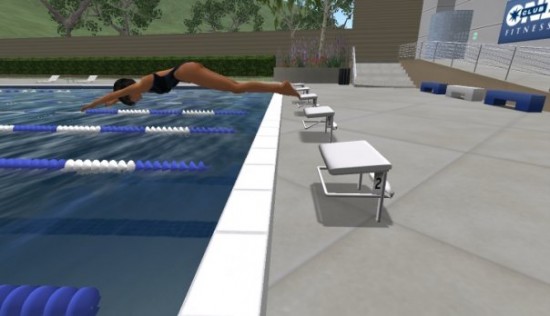
DeVaneaux originally started at Club One building the company’s physical facilities, managing new construction, IT and infrastructure. From there, she moved into a senior IT position.
To make the leap to running a major virtual worlds project, she enrolled in a certificate program in virtual worlds at the University of Washington. The program didn’t just equip her with the skills she needed, but also connected her to researchers working in virtual worlds. It was those researchers who helped set up the Club One Island weight loss study.
Phase One: Virtual Walk-throughs
To sell the idea of a virtual world facility to the company, the first step was to create a virtual mock-up of an actual Club One fitness center.
“We frequently partner with real estate developers to bring our fitness centers into their developments,†DeVaneaux said. “But how do we give them the opportunity to see what we have to offer in a way that’s easily accessible?â€
Flying people around can get expensive.
“That is how I was able to get my foot in the door with the organization,†she said. Virtual fitness center not only became a demonstration platform for sales teams, but also a location in which the company could film marketing videos.
In addition, since Club One has employees around the country, the facility became a location for internal training, she said. “I started working for the human resources team on how we can use the site to do sexual harassment training, discrimination training, how to use equipment. In a virtual environment, they can practice engaging with customers and clients. The laundry staff can learn how to utilize the laundry equipment.â€
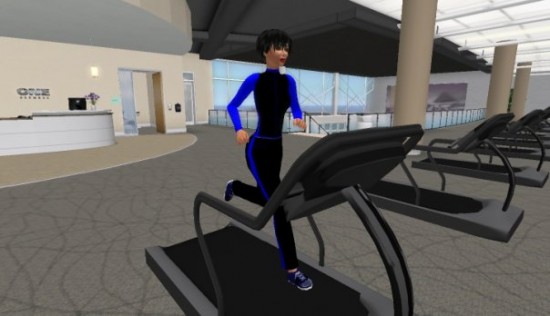
Club One has a total of 2,500 employees in 60 locations around the country, including work-site health and fitness clubs at corporations including Chevron, Audodesk, AOL, and at community centers, universities, and apartment houses.
In addition, the company has 20 clubs with 50,000 members around California.
According to DeVaneaux, this first facility cost around $50,000 to build, but that number is a very rough approximation, she said, and does not include land rental. It took about eight months to build the first island.
Altogether, the Club One Island project took two years, a number internal team members, developers, and outside contractors, she said, and now encompasses four regions in Second Life. Most of the outside building and design work was handled by 2b3d, a “Gold” solution provider for Second Life.
Phase Two: Changing Behaviors
But reducing sales and training costs wasn’t what the Club One Island is all about.
“The biggest area of focus has been to generate revenues,†DeVaneaux said.
They key was to identify the needs that people had that weren’t met by traditional programs, and find a way to create a process to meet those needs.
“I began to design a weight-loss program that I felt would address the psychological needs of our participants,†she said. “The first thing we did was take out the whole concept of diet and exercise. It was almost counter-intuitive for people – ‘You’re telling me you can lose weight by sitting at your computer?’ But the longer you spend on the island, and utilize the tools, the more you will begin almost effortlessly to change your behavior and lose weight and build muscle mass.â€
The fact that there’s no diet for participants to go on means that there’s nothing for them to push back against, she said.
“Instead, what we say is, choose whatever eating plan you want,†she said. “What we will teach you are things about nutrition and how to change your behavior and how you think about food and yourself, so you can be successful on those healthy eating plans.â€
Everybody gets something different out of the program, she said. Some people like to return to the “Room of Doom,†a 3D game where they bash unhealthy junk foods that follow them around. Others go to the “Say No Room†where voicing reminiscent of family members, coworkers and waiters urge visitors to have another helping, to try a new treat, to celebrate a special occasion with a big unhealthy meal.
“Rigidity causes us to fail,†she said. “But if we each, individually, are able to grab those tools that work best for us, we can lead our lives. This isn’t a quick fix, it’s a lifestyle change program. It will change how you relate to yourself, to your body, and to the people in your life as it relates to food.â€
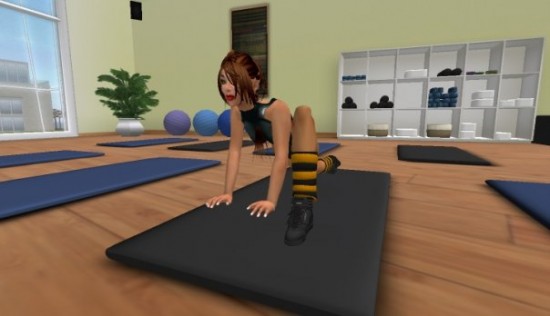
Platform choice
DeVaneaux said that she considered other platforms before deciding to place the Club One facility in Second Life.
“We analyzed costs as well as what the virtual world limitations were, and which virtual worlds we thought were going to continue to be around in the long run,†she said.
She finally settled on Second Life because of the ability to build absolutely anything, which many other platforms did not offer. In addition, some enterprise platforms, including Second Life Enterprise, had significantly higher setup costs. The behind-the-firewall enterprise platforms also required that the club run the software itself, which would impose additional burdens on its technical staff.
As it is, running the programs on the island required a lot of staff. Some very high-powered staff.
For example, program participants teleporting in for their sessions would first check in with Jim Kavanaugh (“Author Ames” in Second Life), who’s worked as a technology manager at Microsoft, Cisco, Fujitsu and Data General. Users who had trouble getting their sound to work, or their software updated, would turn to him, first.
Each session would also be watched over by Audrey Kavanaugh (“Emerson Iwish” in Second Life), with a background in anthropology, education, and leadership training. Today, she is a designer and developer of functional virtual environments.
Habit changer sessions were led by Kari Baker (“Karise Marabana” in Second Life), who has seven years of experience as a social worker, and ten as a certified group fitness instructor.
Movement sessions were led by Roxanne Christman-Kono (“Inspire Inaka” in Second Life), a certified personal trainer with several years of experience working with corporate clients and groups.
Nutrion sessions were led by Lachael Prouty (“Healthy Wonder” in Second Life), a sports and wellness nutritionist with a Master’s in nutrition and experience working with both amateur and professional athletes.
The support sessions were led by Kate Sadowsky (“Curiosity Kamala” in Second Life), a wellness coach with a Master’s in holistic health education. She is also a health writer and a meditation instructor.
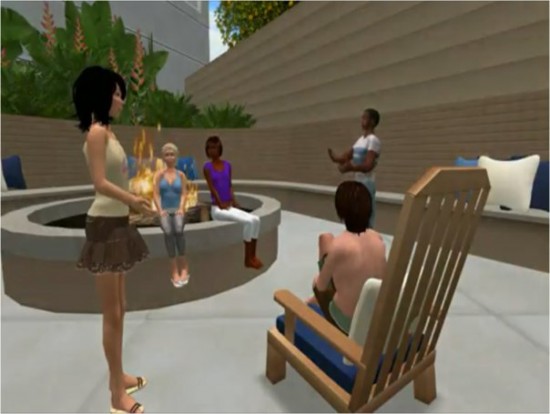
Despite the manpower, things would often go wrong.
“We knew that the biggest barrier to this — and still is the largest barrier to this program — is the technical requirements,” said DeVaneaux.
Voice frequently failed for either the participants or the instructors, teleports would go awry, and there was one session when nobody could log into Second Life at all, and the class was conducted via conference call.
It didn’t help that Second Life was updating its software as the program went on, forcing users to download and install a new viewer.
Club One staffers had to scramble to keep up with the changes, and to help the program participants over the installation hurdles.
In addition, there were occasional bugs in the training tools and simulations that only became apparent after they were deployed. Support staffers occasionally had to reset scripts and fix problems while the groups were in session.
Future expansion
Club One owns the rights to its virtual content, so can expand the program as needed, or license it to other organizations.
For example, existing corporate clients might request a private island just for their employees, DeVaneaux said.
In addition, if more people sign up for the program than the current four-region facility can hold, expansion would be straightforward. “Then we will start throwing down exact replicas of these islands to expand out,” she said.
In addition, the same approach could be used to address other issues beyond fitness and nutrition, she added.
“We already designed other behavior change models — ten programs ready to go after we fine-tune this one,” she said. They include stress reduction, smoking cessation, and feeding children, she said.
- International singers gather on Alternate Metaverse Grid for first annual International Day - April 15, 2024
- OpenSim hits new land, user highs - April 15, 2024
- Wolf Territories rolls out speech-to-text to help the hearing impaired - April 15, 2024
